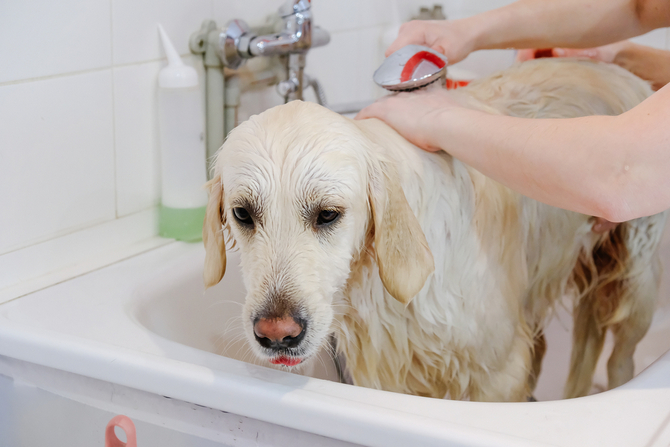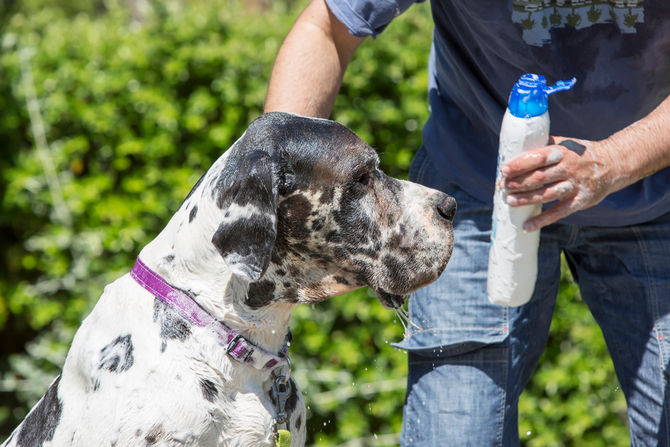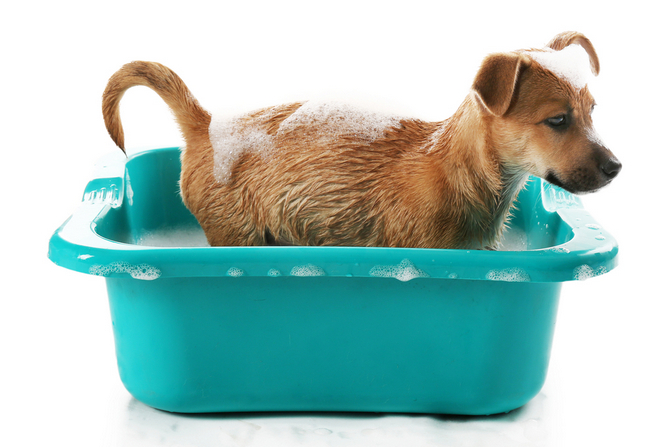Bathing your dog doesn’t always end in a perfect Instagram moment. Not all owners have the luxury of having a blithesome bath time with their canine companions. In fact, most dogs are more than willing to duel you hammer and tongs just to avoid baths, at worst.
Overall, dogs are clean creatures although they don’t mind getting dreggy and fusty during playtime. Similar to cats, they clean up their selves especially when they have been exposed outdoors. Regardless, a dog bath should always remain a critical part of your pet’s regimen.

Bathing your dog not only washes off stubborn grime and leaves him smelling like coconuts, it also provides you with the chance to examine him head to toe, so you can determine his overall condition and keep an eye on any possible medical concerns.
How Often Should I Bathe My Dog?
The Internet abounds with advice that suggests dogs only need yearly baths, which sounds absolutely unideal especially for dogs who carry a potpourri of smells due to their genetic makeup. When it comes to dog baths, frequency depends on a number of factors; this includes your dog’s breed, fur density and length, habits, and activities that your dog engages in, etc.
Chihuahuas, for instance, have low grooming demands due to their short, smooth coat and that they are also content with bossing around indoors. Hence, a monthly bath is enough to keep their funny smells at bay. On the other hand, long-haired dogs, particularly those with double coats such as the pompous Pomeranian, would benefit from a weekly bath and daily brushing. Otherwise, they would lose their fluffy charm.
Meanwhile, outdoorsy dogs who love rolling in the grass or infesting your garden with tunnels are the ones who need more frequent baths than those who prefer lounging on the sofa all day. Should your dog come home soggy and dirty, then bathe him right away. Cheesy smells are tolerable, but surely you wouldn’t want to snuggle a dirty dog.

Overall, there is no standard frequency for dog baths. Weekly baths, however, would be beneficial for healthy dogs. Doing so eliminates the accumulation of dander and allergens that could cause skin issues in our canine companions. Thankfully, we now have the convenience of dog shampoos and conditioners that don't strip off the natural oils of our pets so they remain healthy, fresh, and happy.
What If My Dog Has Skin Problems?
If your dog has skin problems, however, you need to bathe him using a medicated shampoo more than once a week. The frequency depends entirely on the product or your veterinarian’s instructions after his assessment. Our canine companions with skin issues don’t clean as effectively as their healthier brothers; hence, contaminants may build up including excess excretions, which could produce unpleasant smells and a habitable place for microorganisms to proliferate. Therefore, you need to bathe your dog more often to minimize the bacterial load and alleviate inflammation. Therapeutic baths also provide a cost-effective relief from itchiness and irritation.
When Should I Give My Puppy His First Bath?
Your dog’s very first bath is among the most critical moments of his life and an unforgettable one to boot. Training your pup that baths are an indispensable part of his life is the key to avoiding problems in the future. Older dogs who aren’t accustomed to bathing at an early age would find bath time a traumatic experience. To avoid such a circumstance, start giving your puppy weekly baths as soon as he has been weaned or when he reaches two months old.

Puppies are feeble and vulnerable to diseases since their immune system has yet to develop; thus, timing must be properly observed. If your pup gets dirty but is too young for a bath, you may use wet tissues to keep him squeaky clean and fresh. Puppies are cute and clumsy babies with fur, so it is sure to occur that he would get soaked on his own pee, roll on his own poop; or better yet, befriend the skunk next door.
What If My Pup Has Mange or Fleas?
Sadly, some puppies have to go through hard knocks at a tender age. Some pups were left in the lurch by irresponsible owners, while others lost their mothers in an accident; thus, they get filthy and malnourished.
If you happen to save a pup suffering a mange or flea infestation, the wisest thing to do is to seek professional help right away. Chances are, your pup is also suffering from internal parasites. Your veterinarian will provide medication suitable for sensitive puppies.
Never use any flea product: be it shampoo, soap, collar, body powder, etc. Puppies cannot tolerate the active ingredients that flea products contain. Otherwise, puppies will suffer serious adverse effects. The only solution is to offer your pup a warm bath until he is old enough for flea treatments. Also, you have to eliminate external parasites manually or use an anti-lice brush.
Can I Bathe a Dog Using My Shampoo?
Dog shampoos have certainly evolved from simply deodorizing our pets to treating several skin issues. Today, there are all-purpose shampoos, therapeutic shampoos, flea shampoos and specially formulated shampoos for different skin types. The product you choose should cater to your desired results or the reason for the bath.
The first rule of thumb is never to use human shampoos (even baby shampoos) on dogs. The pH level of our pets’ skin differs from ours. Therefore, a shampoo formulated for humans can disrupt the balance of your pet’s skin and may cause it to become dry and irritated.
Where Should I Bathe My Dog?
You can easily bathe a small dog using any sink, but if your pet enjoys doing doggie paddles, then putting him in the bathtub would be a better idea. It is impossible, on the other hand, to bathe a medium-sized dog in a sink. If a tub is unavailable, simply block the drain, make a puddle, and let him enjoy the drizzle. Playing games while taking a bath also encourages your pet to love baths even more. Just make sure you close the bathroom door!
In addition, it is much easier to bathe large dogs in the yard. You don’t have to keep lifting a heavy dog who persistently jumps out of the bathtub. This way, your pet can also have fun playing around all the while getting a bath. You just need a garden hose and of course, a fence.
Just in case you get busy, know that there are bathing facilities readily available to cater to your pet's needs. Professional groomers will make sure your dog will be looking sleek and feeling fresh when you fetch him.

Dog Bathing Guide
- Gather bath essentials. You will need the following:
- Dog shampoo
- Towels
- Rubberized mat
- Cotton balls
- Hairbrush
- Flea comb (optional)
- Squeaky toys and treats (optional)
- Set up the place.
- Your materials should be close at hand. If a showerhead is unavailable, you will need a pail or a small jug for pouring water.
- Place a non-skid mat in front of the bathtub to prevent your dog from slipping when he comes out dripping wet.
- Ensure the water temperature is right.
- Prepare your dog for bathing.
- Brush your dog beforehand especially if you have a fluffy one. This is a vital part of your dog’s pre-bathing routine to loosen tangled hair or matted fur.
- Trim your pet’s nails. This will help prevent any accidental scraping if he struggles in the process. If you’re not confident with your trimming skills, you may ask for a groomer’s help in exchange for a small fee. Remember that any lack of confidence on your part is swiftly telegraphed to your dog.
- Remove your dog’s collar to make sure his neck area can be cleansed thoroughly regardless if it’s waterproof or not.
- Manually remove (and kill) visible ticks and fleas using a flea comb.
- Getting water into your pet’s ear canals causes pain, so never forget to tuck a small cotton ball in each doggie ear to keep them dry.
- Reward your dog a yummy biscuit as soon as he gets into the tub. The easiest way to make him obey is by putting his favorite chew toys in the tub. You can hand him several treats throughout the entire bathing process too.
- Start wetting your dog slowly from the neck towards his rear. As soon as he gets comfortable, you may gradually increase the shower head’s pressure or the amount of water you douse on his body. It is best to omit his face. You may use a small towel slightly drenched in sudsy water to cleanse his face and ears. Then use another wet towel to wipe off the shampoo residue from his face. After all, dogs love getting rubbed.
- Pour a generous amount of your preferred shampoo on your palm. Rub it against both hands before you apply it directly onto your dog’s fur. Lather up. The mechanical action of bathing your pet helps slough off dead skin cells as well as removing allergens, bacteria, or fungi that may have accumulated on the skin.
- For this step, you should follow the instructions given on the dog shampoo or by your veterinarian. Some shampoos need to be left on the skin for five minutes or more before rinsing off. Hence, keep your pet occupied by allowing him to play with his toys.
- If you have to use a dog conditioner for a long-haired or double-coated dog, dry him with a towel first before applying the conditioner as you would do in your hair.
- Rinse, rinse, rinse! Make sure no shampoo or conditioner residue is left; otherwise, it will become itchy when it dries. While doing so, never cease praising your pet and remind him what a good boy he is.
- Lastly, dry your dog using a high-absorption towel. Brush your dog’s coat while it is still drying. Using a hair dryer can speed up the process. Don’t forget to remove the cotton balls! As soon as his bath is done, give him a reward he could never refuse so he will look forward to the next bath because of the prize.
Tips
- Make every bath a positive experience even if your pooch is uncooperative at first. Never yell or allow your facial expression to go sour for this will only frustrate your pooch even more.
- Associate bath time with fun and games.

Why Is He Drenching the House?
Dogs get an instant energy boost after every refreshing bath. Likewise, it seems every owner has a dog that saturates the house like a crazy banshee after every bath. Comfy bathrobes are available for the pampered pooch, but they are mostly made for fashion. To prevent your dog from drenching the house, schedule bath time more carefully. On a beautiful sunny day, you can wash your dog outside where he can race around drying au naturel. Better yet, place a large high-absorbent towel on his bed with some attention-grabbing toys or snacks. Dogs also love to burrow after baths and make twists and turns on their beds to dry themselves.
Final Thoughts
If you want to turn each dog bath into a beautiful bonding moment with your pet, you need to combine patience and basic dog training to achieve it. However, owners must never push their dog’s limits, especially when you are still introducing bath to them. You must handle the bathing process with utmost care and understand the needs of your canine companion. This is especially important for dogs who were adopted from shelters. You have no idea if your newly adopted dog has encountered an unpleasant experience with water. It is important that you encourage him with a positive attitude and rewards all the time, even if he is being uncooperative at first. Sooner or later, he will begin to associate bathing with a positive outcome. Moreover, it is wise to opt for products designed for dogs alone. If you are unsure which product to choose, your veterinarian can offer advice which shampoo is most suitable for your pet; especially if he has certain skin issues.